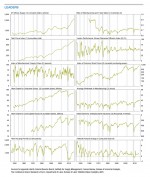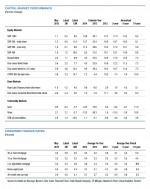Pulling It All Together/Appendix
Overview
The Economy…
Our business-cycle leader’s index picked up in May, jumping to 64 following three months at the neutral 50 level. Despite a poor first-quarter performance amid unusually harsh weather, we expect real GDP to return to a moderate pace of growth, with private domestic demand faring even better. We base our analysis on sound fundamentals seen in key areas, including consumer spending, business investment, and to a lesser degree, residential housing. An improving economy should encourage moderate credit growth and an opportunity for lenders to boost income. Commercial bank lending has expanded in key categories for several years as financial institutions capitalize on interest rates that have remained near historic lows.
…Inflation…
Recent data suggest a reemergence of inflationary pressures. Overall, 12 out of 23 measures tracked by our inflationary pressures scorecard point to rising price pressures, up from nine last month. Energy prices have rebounded from the plunge in the last half of 2014, while the coincident rally in the U.S. dollar tailed off in March. Since then, the depreciating value of the currency has pushed up import prices.
…Inflation…
Recent data suggest a reemergence of inflationary pressures. Overall, 12 out of 23 measures tracked by our inflationary pressures scorecard point to rising price pressures, up from nine last month. Energy prices have rebounded from the plunge in the last half of 2014, while the coincident rally in the U.S. dollar tailed off in March. Since then, the depreciating value of the currency has pushed up import prices.
The Consumer Price Index rose in April for the third straight month. The increase in food prices, which lasted throughout 2014, has stalled this year. At the same time, energy prices have firmed. These two forces largely offset one another, resulting in only a mild increase in the overall CPI. The increase in core CPI, which excludes volatile food and energy prices, remains close to its long-term historical average.
…Policy…
Fed officials continue to explain their thinking and current views on the economy while laying out their framework for reaching a decision on “liftoff.” They need to see continued improvement in the labor market and they need to have “reasonable confidence” that inflation is headed back up to the 2 percent goal. Projections by Fed members for the outlook for inflation suggest confidence has weakened recently.
Fed Chair Yellen noted in a recent speech that the FOMC would proceed cautiously during the period of policy normalization, that she and her colleagues at the Fed are data-dependent, and that interest rates are not on a predetermined course. We expect the first rate increase later this year but only periodic increases after the initial “liftoff.”
…Investing
Credit growth is typical for a healthy and expanding economy and is a positive development for financial stocks. For some financials, the rebound in equity markets and the improving economy have been positive supports. The low interest-rate environment can benefit issuers of debt but can be a challenge for lenders who earn income on spreads, or the difference between what they charge borrowers for loans and what they pay for the money they lend.
Financial stocks in the U.S. have trailed the rebounding S&P 500, which has marched to fresh records at least 10 times this year, yet conditions suggest support for further gains. Global financial shares have performed best in emerging markets and Asia outside Japan. Sector stocks with the biggest growth potential—and the greatest risk—may be found in Europe and Japan.
Next/Previous Section:
1. Overview
2. Economy
3. Inflation
4. Policy
5. Investing
6. Pulling It All Together/Appendix




